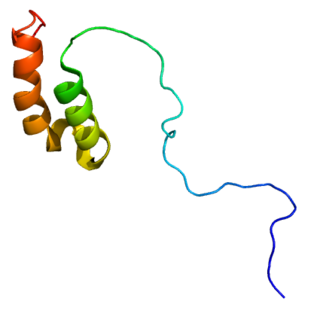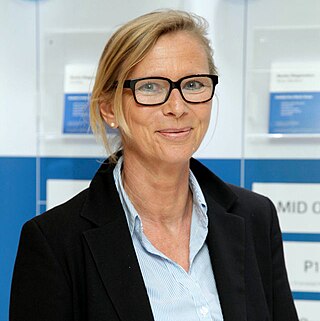
The enzyme cytochrome c oxidase or Complex IV, is a large transmembrane protein complex found in bacteria, archaea, and mitochondria of eukaryotes.

Cytochrome c oxidase I (COX1) also known as mitochondrially encoded cytochrome c oxidase I (MT-CO1) is a protein that in humans is encoded by the MT-CO1 gene. In other eukaryotes, the gene is called COX1, CO1, or COI. Cytochrome c oxidase I is the main subunit of the cytochrome c oxidase complex. Mutations in MT-CO1 have been associated with Leber's hereditary optic neuropathy (LHON), acquired idiopathic sideroblastic anemia, Complex IV deficiency, colorectal cancer, sensorineural deafness, and recurrent myoglobinuria.

Cytochrome c oxidase subunit 2, also known as cytochrome c oxidase polypeptide II, is a protein that in humans is encoded by the MT-CO2 gene. Cytochrome c oxidase subunit II, abbreviated COXII, COX2, COII, or MT-CO2, is the second subunit of cytochrome c oxidase. It is also one of the three mitochondrial DNA (mtDNA) encoded subunits of respiratory complex IV.

Cytochrome c oxidase subunit III (COX3) is an enzyme that in humans is encoded by the MT-CO3 gene. It is one of main transmembrane subunits of cytochrome c oxidase. It is also one of the three mitochondrial DNA (mtDNA) encoded subunits of respiratory complex IV. Variants of it have been associated with isolated myopathy, severe encephalomyopathy, Leber hereditary optic neuropathy, mitochondrial complex IV deficiency, and recurrent myoglobinuria.

Surfeit locus protein 1 (SURF1) is a protein that in humans is encoded by the SURF1 gene. The protein encoded by SURF1 is a component of the mitochondrial translation regulation assembly intermediate of cytochrome c oxidase complex, which is involved in the regulation of cytochrome c oxidase assembly. Defects in this gene are a cause of Leigh syndrome, a severe neurological disorder that is commonly associated with systemic cytochrome c oxidase deficiency, and Charcot-Marie-Tooth disease 4K (CMT4K).

Protein SCO1 homolog, mitochondrial, also known as SCO1, cytochrome c oxidase assembly protein, is a protein that in humans is encoded by the SCO1 gene. SCO1 localizes predominantly to blood vessels, whereas SCO2 is barely detectable, as well as to tissues with high levels of oxidative phosphorylation. The expression of SCO2 is also much higher than that of SCO1 in muscle tissue, while SCO1 is expressed at higher levels in liver tissue than SCO2. Mutations in both SCO1 and SCO2 are associated with distinct clinical phenotypes as well as tissue-specific cytochrome c oxidase deficiency.

Cytochrome c oxidase copper chaperone is a protein that in humans is encoded by the COX17 gene.

Cytochrome c oxidase subunit 4 isoform 1, mitochondrial (COX4I1) is an enzyme that in humans is encoded by the COX4I1 gene. COX4I1 is a nuclear-encoded isoform of cytochrome c oxidase (COX) subunit 4. Cytochrome c oxidase is a multi-subunit enzyme complex that couples the transfer of electrons from cytochrome c to molecular oxygen and contributes to a proton electrochemical gradient across the inner mitochondrial membrane, acting as the terminal enzyme of the mitochondrial respiratory chain. Antibodies against COX4 can be used to identify the inner membrane of mitochondria in immunofluorescence studies. Mutations in COX4I1 have been associated with COX deficiency and Fanconi anemia.

Cytochrome c oxidase subunit 6B1 is an enzyme that in humans is encoded by the COX6B1 gene. Cytochrome c oxidase 6B1 is a subunit of the cytochrome c oxidase complex, also known as Complex IV, the last enzyme in the mitochondrial electron transport chain. Mutations of the COX6B1 gene are associated with severe infantile encephalomyopathy and mitochondrial complex IV deficiency (MT-C4D).

Protoheme IX farnesyltransferase, mitochondrial is an enzyme that in humans is encoded by the COX10 gene. Cytochrome c oxidase (COX), the terminal component of the mitochondrial respiratory chain, catalyzes the electron transfer from reduced cytochrome c to oxygen. This component is a heteromeric complex consisting of 3 catalytic subunits encoded by mitochondrial genes and multiple structural subunits encoded by nuclear genes. The mitochondrially-encoded subunits function in electron transfer, and the nuclear-encoded subunits may function in the regulation and assembly of the complex. This nuclear gene, COX10, encodes heme A: farnesyltransferase, which is not a structural subunit but required for the expression of functional COX and functions in the maturation of the heme A prosthetic group of COX. A gene mutation, which results in the substitution of a lysine for an asparagine (N204K), is identified to be responsible for cytochrome c oxidase deficiency. In addition, this gene is disrupted in patients with CMT1A duplication and with HNPP deletion.

Cytochrome c oxidase subunit 6A1, mitochondrial is a protein that in humans is encoded by the COX6A1 gene. Cytochrome c oxidase 6A1 is a subunit of the cytochrome c oxidase complex, also known as Complex IV, the last enzyme in the mitochondrial electron transport chain. A mutation of the COX6A1 gene is associated with a recessive axonal or mixed form of Charcot-Marie-Tooth disease.

Cytochrome c oxidase subunit 7B, mitochondrial (COX7B) is an enzyme that in humans is encoded by the COX7B gene. COX7B is a nuclear-encoded subunit of cytochrome c oxidase (COX). Cytochrome c oxidase is a multi-subunit enzyme complex that couples the transfer of electrons from cytochrome c to molecular oxygen and contributes to a proton electrochemical gradient across the inner mitochondrial membrane, acting as the terminal enzyme of the mitochondrial respiratory chain. Work with Oryzias latices has linked disruptions in COX7B with microphthalmia with linear skin lesions (MLS), microcephaly, and mitochondrial disease. Clinically, mutations in COX7B have been associated with linear skin defects with multiple congenital anomalies.

Cytochrome c oxidase assembly protein COX15 homolog (COX15), also known as heme A synthase, is a protein that in humans is encoded by the COX15 gene. This protein localizes to the inner mitochondrial membrane and involved in heme A biosynthesis. COX15 is also part of a three-component mono-oxygenase that catalyses the hydroxylation of the methyl group at position eight of the protoheme molecule. Mutations in this gene has been reported in patients with hypertrophic cardiomyopathy as well as Leigh syndrome, and characterized by delayed onset of symptoms, hypotonia, feeding difficulties, failure to thrive, motor regression, and brain stem signs.

Cytochrome c oxidase subunit 8A (COX8A) is a protein that in humans is encoded by the COX8A gene. Cytochrome c oxidase 8A is a subunit of the cytochrome c oxidase complex, also known as Complex IV. Mutations in the COX8A gene have been associated with complex IV deficiency with Leigh syndrome and epilepsy.

Michaela Jaksch-Angerer is a German medical doctor, consultant in laboratory medicine, and Associate Professor for Clinical Chemistry. She has held the position of "Managing and Medical Director" since 2004 at the Freiburg Medical Laboratory Middle East LLC, Dubai, UAE, a member of Synlab since 2013. FML was founded in 2002 as a joint venture of the University of Freiburg Germany and the Al Abbas Group, Dubai, UAE.

Cytochrome c oxidase assembly factor 3, also known as Coiled-coil domain-containing protein 56, or Mitochondrial translation regulation assembly intermediate of cytochrome c oxidase protein of 12 kDa is a protein that in humans is encoded by the COA3 gene. This gene encodes a member of the cytochrome c oxidase assembly factor family. Studies of a related gene in fly suggest that the encoded protein is localized to mitochondria and is essential for cytochrome c oxidase function.
Cytochrome c oxidase assembly factor 5 is a protein that in humans is encoded by the COA5 gene. This gene encodes an ortholog of yeast Pet191, which in yeast is a subunit of a large oligomeric complex associated with the mitochondrial inner membrane, and required for the assembly of the cytochrome c oxidase complex. Mutations in this gene are associated with mitochondrial complex IV deficiency.

Cytochrome c oxidase assembly factor COX14 is a protein that in humans is encoded by the COX14 gene. This gene encodes a small single-pass transmembrane protein that localizes to mitochondria. This protein may play a role in coordinating the early steps of cytochrome c oxidase subunit assembly and, in particular, the synthesis and assembly of the COX I subunit of the holoenzyme. Mutations in this gene have been associated with mitochondrial complex IV deficiency. Alternative splicing results in multiple transcript variants.
Cytochrome c oxidase assembly factor COX20 is a protein that in humans is encoded by the COX20 gene. This gene encodes a protein that plays a role in the assembly of cytochrome c oxidase, an important component of the respiratory pathway. Mutations in this gene can cause mitochondrial complex IV deficiency. There are multiple pseudogenes for this gene. Alternative splicing results in multiple transcript variants.

Cytochrome c oxidase assembly factor 6 is a protein that in humans is encoded by the COA6 gene. Mitochondrial respiratory chain Complex IV, or cytochrome c oxidase, is the component of the respiratory chain that catalyzes the transfer of electrons from intermembrane space cytochrome c to molecular oxygen in the matrix and as a consequence contributes to the proton gradient involved in mitochondrial ATP synthesis. The COA6 gene encodes an assembly factor for mitochondrial complex IV and is a member of the cytochrome c oxidase subunit 6B family. This protein is located in the intermembrane space, associating with SCO2 and COX2. It stabilizes newly formed COX2 and is part of the mitochondrial copper relay system. Mutations in this gene result in fatal infantile cardioencephalomyopathy.


















